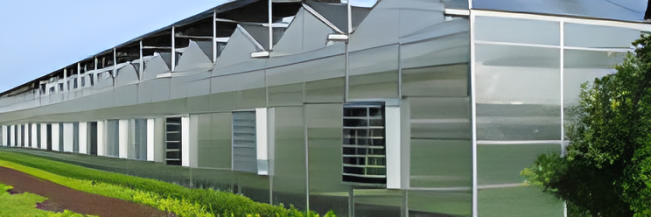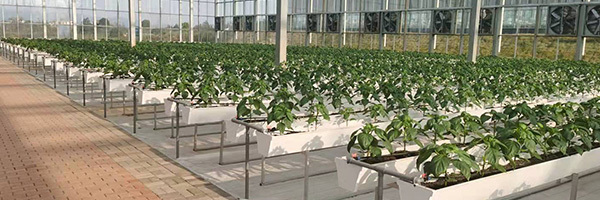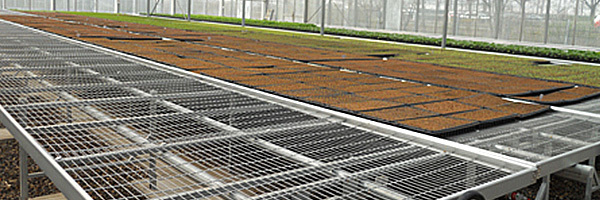-
-
Company Profile
-

Greenhouse Structures

-
Polycarbonate sheet greenhouse
-
Glass greenhouses
-
Multi-Span film greenhouse
-
Solar greenhouse
-
Sightseeing greenhouse
-
Double-film frame solar greenhouses
-
Glass and polycarbonate sheet greenhouses
-
Glass greenhouses structures suitable for planting
-
Glass Greenhouse for Scientific Research
View More -
-

-

Photovoltaic greenhouse
Release time:
2025-05-20

Main Features and Benefits of Photovoltaic Agricultural Greenhouse
Brief Introduction of 1. Photovoltaic Agricultural Greenhouse
Photovoltaic agricultural greenhouse is a greenhouse integrating solar photovoltaic power generation, intelligent temperature control system and modern high-tech planting. The greenhouse adopts steel skeleton and is covered with solar photovoltaic modules, while ensuring the lighting demand of solar photovoltaic power generation and crops in the whole greenhouse. The amount of electricity generated by solar photovoltaic can support the irrigation system of the greenhouse, fill the light of plants, solve the winter heating demand of the greenhouse, increase the temperature of the greenhouse, and promote the rapid growth of crops.
Advantages of 2. photovoltaic agricultural greenhouses
Photovoltaic agricultural greenhouse is a new mode of photovoltaic application. Compared with the construction of centralized large-scale photovoltaic ground power station, photovoltaic agricultural greenhouse project has many advantages:
1. Effectively alleviate the contradiction between people and land, and promote the sustainable development of social economy
Photovoltaic agricultural greenhouse power generation components use the roof of the agricultural greenhouse, do not occupy the ground, will not change the nature of land use, so it can save land resources. It can play a positive role in effectively reversing the significant decline in arable land in the face of a large increase in population. On the other hand, photovoltaic projects are built on the original agricultural cultivated land, and the quality of the land is good, which is conducive to the development of modern agricultural projects. The development of modern agriculture and supporting agriculture is conducive to the combination of the secondary and tertiary industries and the primary industry. And it can directly increase the income of local farmers.
2, can flexibly create a suitable environment for the growth of different crops
By erecting solar panels with different light transmittance on agricultural greenhouses, it can meet the lighting needs of different crops. It can grow organic agricultural products, precious seedlings and other high value-added crops, and can also realize off-season planting and high-quality planting.
3, to meet the demand for agricultural electricity, generate power generation benefits
The use of roof power generation can meet the power demand of agricultural greenhouses, such as temperature control, irrigation, lighting, etc., and can also be connected to the grid and sold to power grid companies to realize income and generate benefits for investment enterprises.
4. New path of green agricultural production
Compared with traditional agriculture, it pays more attention to the input of scientific and technological elements, pays more attention to operation and management, and pays more attention to the improvement of the quality of laborers. As a new type of agricultural production and management model, while driving the promotion and application of regional agricultural science and technology, through the realization of Agricultural science and technology and agricultural industrialization will become a pillar industry for regional agricultural efficiency and farmers' income.
Planting of 3. Photovoltaic Agricultural Greenhouse
1. Crops with high economic value
Photovoltaic agricultural greenhouses can focus on the development of organic characteristic vegetables, edible fungi and Chinese herbal medicine facility production, moderate development of ornamental seedling planting, and increase the value of unit land output and the added value of agricultural products.
Most edible fungus mycelium growth stage does not need light, weak light also has no adverse reaction, can grow edible fungus planting mushrooms, Pleurotus ostreatus, Agaricus bisporus and Flammulina velutipes and other varieties;
According to the different requirements of light intensity, vegetables can be divided into vegetables that require strong light, vegetables that are suitable for medium light and vegetables that are relatively resistant to weak light. Low light resistant vegetables mainly include celery, asparagus, spinach, ginger, leek, lettuce, dandelion, water spinach, fungus, etc;
Negative and yin-resistant Chinese herbal medicines include American ginseng, Coptis, Codonopsis, Ophiopogon japonicus, Panax notoginseng, Atractylodes, Pinellia, Gastrodia, Ganoderma, etc;
Can be cultivated in the greenhouse shade-resistant seedlings, potted plants, flowers and so on.
2, can be developed into sightseeing agriculture
Take advantage of good transportation and location advantages, make full use of the two major resources of agricultural production and ecological environment, rely on eco-tourism resources such as ornamental seedlings, and cooperate with the development and construction of agricultural tourism resources such as the production and picking of organic vegetables and other agricultural products, and develop various forms of sightseeing and leisure Tourism projects such as experience have formed a characteristic and large-scale sightseeing agriculture.
4. forms of construction
The construction of photovoltaic agricultural greenhouses is mainly integrated thin-film photovoltaic greenhouses (power generation components and steel frame flexible connection), professional transformation on the original greenhouses, etc. General new greenhouses in accordance with the integration of construction, as shown in the figure below.
The greenhouse power generation components can be selected from thin film components, polycrystalline silicon and monocrystalline silicon components. Compared with ordinary greenhouses, the steel frame structure of photovoltaic greenhouses is complicated and the cost is relatively higher than that of ordinary greenhouses.
Power Generation of 5. Photovoltaic Greenhouse
1. Power generation
Photovoltaic greenhouses are generally arranged with a photovoltaic greenhouse per mu of land, with an area of about 60m * 8.5m, and each greenhouse can be arranged with about 60kW. According to the solar energy resources in Weihai, the number of hours of production is about 1274 hours. Taking the installation capacity of 20MW as an example, the average annual power generation is about 25.48 million kWh, and the total power generation in 25 years is 63700 million kWh.
2. Electricity price and subsidy
There are two ways to consume the power generated by photovoltaic greenhouses: one is a small-scale distributed photovoltaic power station (e.g. less than 6MW), which uses spontaneous self-use surplus electricity to connect to the Internet, and the generated electricity is sold to users of agricultural greenhouses or other users according to the sales price of the power grid. The remaining electricity is integrated into the power grid, and a subsidy of 0.42 yuan/W of total electricity can be obtained. One is large-scale, directly integrated into the grid, the on-grid electricity price is calculated in accordance with "Lu Price Yi Fa [2013] Document No. 119, and the on-grid electricity price of photovoltaic power stations connected to the grid from 2013 to 2015 is determined to be 1.2 yuan per kilowatt-hour (including tax, the same below). Can apply for national photovoltaic building integration subsidies,
Agricultural projects can also apply for subsidies and financial subsidies for related agricultural projects, such as the "vegetable basket" product production fruit and vegetable project of Shandong Provincial Department of Agriculture and Department of Finance. In addition, if the distributed project is not more than 20MW, it can be connected to the Internet according to the local photovoltaic benchmark electricity price, and the filing can enter the distributed photovoltaic scale control index.
Benefit Analysis of 6. Power Generation
Taking a 20MW photovoltaic project as an example, the construction content of photovoltaic greenhouse includes: the construction and installation cost of photovoltaic system, the project land cost, the construction cost of agricultural greenhouse body, and the access system cost, totaling about 12470 yuan/kW.
Calculation parameter setting: considering the land lease cost: 1200 yuan/mu per year; The electricity price is 1.2 yuan/kWh; The dynamic total investment of the project is 249.4102 million yuan, the total sales tax and surcharge is 11.6032 million yuan, and the total value-added tax paid is 133.2802 million yuan.
Using the above parameters, the results are as follows:
After the completion of the greenhouse, it is assumed that the rental income is 1200 yuan/mu per year, the pre-tax internal rate of return before project financing is 8.93, and the internal rate of return after capital tax is 10.70. The payback period is 10.11 years.
After the completion of the greenhouse is not rented, the project financing before the pre-tax internal rate of return is 8.55, the capital after-tax internal rate of return is 9.43, the investment payback period is 10.39 years.
If the project power generation can be fully connected to the grid, the enterprise can still maintain an internal rate of return of more than 8% after paying the cost of photovoltaic greenhouse land.
7. epilogue
To sum up, photovoltaic agricultural greenhouse is a new form of comprehensive land utilization, which is the product of the close combination of modern agriculture and clean energy. The project saves land, does not change the land attribute, and can make three-dimensional use of space, generate clean electricity, expand the proportion of renewable energy in power supply, and bring two-way benefits.
The use of photovoltaic greenhouses can promote green agricultural production and realize scientific and efficient circular ecological agriculture. The photovoltaic greenhouse project can be built into a modern agricultural demonstration and education base, integrating agricultural activities and scientific and technological demonstration, giving full play to the effect of industrial clusters, prospering the regional economy, and building a model and window for provincial and municipal characteristic agriculture.
Keyword:
Related News
Exploring the Benefits of Glass and Polycarbonate Sheet Greenhouses in Modern Agriculture
Greenhouses have become an integral part of modern agriculture, allowing for extended growing seasons and improved crop yields. Among the various materials used in greenhouse construction, glass and polycarbonate sheets stand out for their unique properties and benefits. Glass greenhouses are renowned for their superior light transmission. With the ability to allow up to 90% of sunlight to penetr
2025-06-01
Energy Savings: How a Green House Glass Roof Can Lower Your Bills
Energy Savings: How a Green House Glass Roof Can Lower Your Bills Table of Contents 1. Introduction to Greenhouse Glass Roofs 2. The Benefits of Installing a Glass Roof 3. Energy Efficiency: A Key Advantage 4. Cost Savings from Energy Efficiency 5. The Environmental Impact of Glass Roofs 6. The Installation Process of a Greenhouse Glass Roof 7. Maintenance Tips for Your Glass Roof 8. Frequently A
2025-05-27
Innovative Glass Greenhouse Structures for Optimal Plant Cultivation
--- In the realm of modern agriculture and horticulture, glass greenhouse structures have emerged as a game-changer for those looking to optimize their planting environments. Unlike traditional methods, glass greenhouses offer a controlled atmosphere that is crucial for plant health and productivity. The transparent nature of glass allows for maximum sunlight penetration, which is essential for ph
2025-05-22
Choosing the Right Glass Greenhouse for Your Research Needs: A Comprehensive Guide
Choosing the Right Glass Greenhouse for Your Research Needs Table of Contents 1. Introduction to Glass Greenhouses 2. Why Choose Glass Over Other Materials? 3. Assessing Your Research Needs for a Greenhouse 4. Different Designs of Glass Greenhouses 4.1 Lean-To Greenhouses 4.2 Freestanding Greenhouses 4.3 Attached Greenhouses 5. Key Features to Co
2025-05-17
Contact
Address: Hebei University of Technology Science and Technology Park, High tech Zone, Cangzhou City, Hebei Province
International Trade Office: Huashang Building, Yunhe District, Cangzhou City (500 meters east of Cangzhou West High speed Railway Station)
Tel:+86 15301369860

Online message
-







